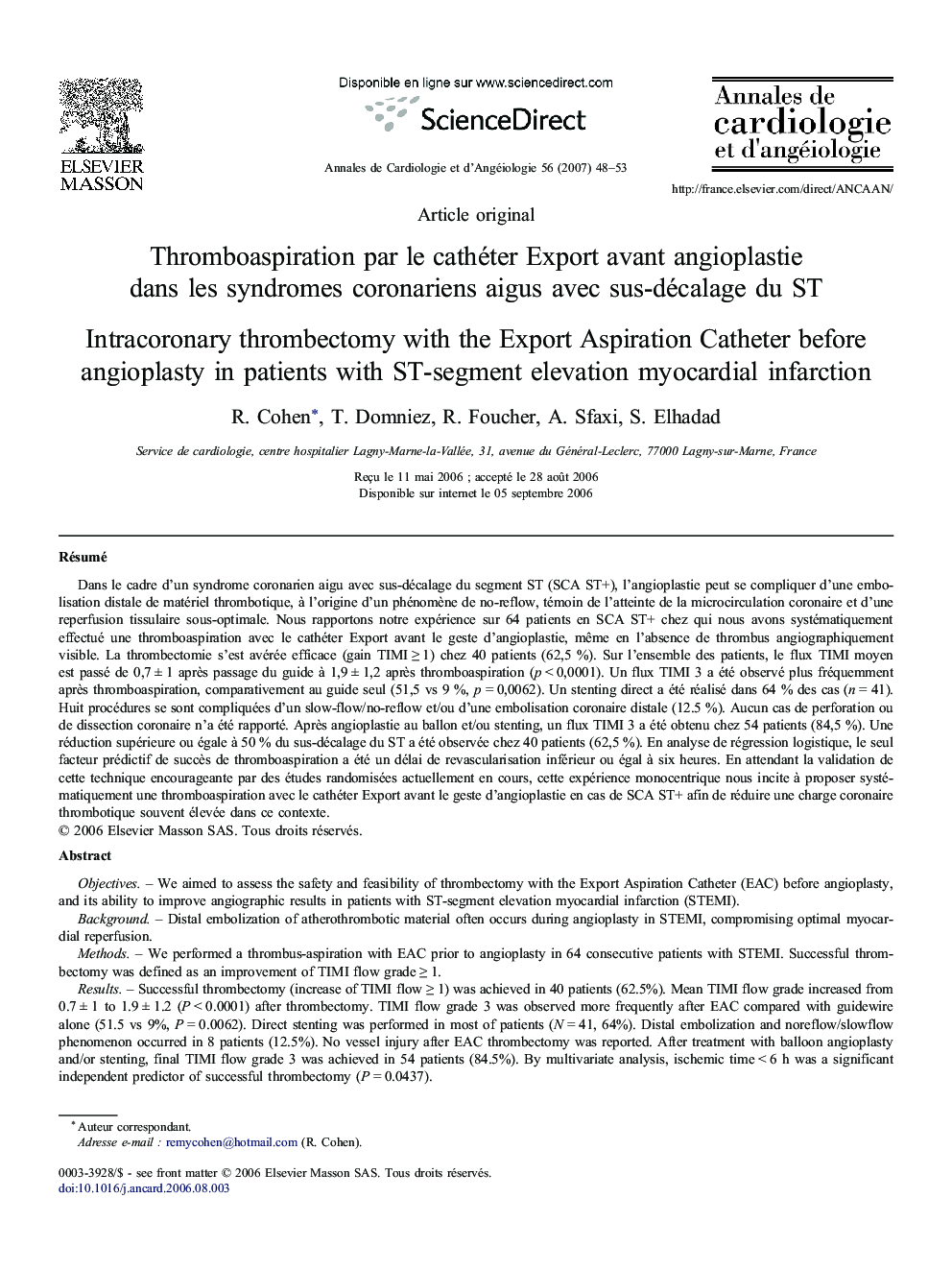| Article ID | Journal | Published Year | Pages | File Type |
|---|---|---|---|---|
| 2869688 | Annales de Cardiologie et d'Angéiologie | 2007 | 6 Pages |
RésuméDans le cadre d'un syndrome coronarien aigu avec sus-décalage du segment ST (SCA ST+), l'angioplastie peut se compliquer d'une embolisation distale de matériel thrombotique, à l'origine d'un phénomène de no-reflow, témoin de l'atteinte de la microcirculation coronaire et d'une reperfusion tissulaire sous-optimale. Nous rapportons notre expérience sur 64 patients en SCA ST+ chez qui nous avons systématiquement effectué une thromboaspiration avec le cathéter Export avant le geste d'angioplastie, même en l'absence de thrombus angiographiquement visible. La thrombectomie s'est avérée efficace (gain TIMI ≥ 1) chez 40 patients (62,5 %). Sur l'ensemble des patients, le flux TIMI moyen est passé de 0,7 ± 1 après passage du guide à 1,9 ± 1,2 après thromboaspiration (p < 0,0001). Un flux TIMI 3 a été observé plus fréquemment après thromboaspiration, comparativement au guide seul (51,5 vs 9 %, p = 0,0062). Un stenting direct a été réalisé dans 64 % des cas (n = 41). Huit procédures se sont compliquées d'un slow-flow/no-reflow et/ou d'une embolisation coronaire distale (12.5 %). Aucun cas de perforation ou de dissection coronaire n'a été rapporté. Après angioplastie au ballon et/ou stenting, un flux TIMI 3 a été obtenu chez 54 patients (84,5 %). Une réduction supérieure ou égale à 50 % du sus-décalage du ST a été observée chez 40 patients (62,5 %). En analyse de régression logistique, le seul facteur prédictif de succès de thromboaspiration a été un délai de revascularisation inférieur ou égal à six heures. En attendant la validation de cette technique encourageante par des études randomisées actuellement en cours, cette expérience monocentrique nous incite à proposer systématiquement une thromboaspiration avec le cathéter Export avant le geste d'angioplastie en cas de SCA ST+ afin de réduire une charge coronaire thrombotique souvent élevée dans ce contexte.
ObjectivesWe aimed to assess the safety and feasibility of thrombectomy with the Export Aspiration Catheter (EAC) before angioplasty, and its ability to improve angiographic results in patients with ST-segment elevation myocardial infarction (STEMI).BackgroundDistal embolization of atherothrombotic material often occurs during angioplasty in STEMI, compromising optimal myocardial reperfusion.MethodsWe performed a thrombus-aspiration with EAC prior to angioplasty in 64 consecutive patients with STEMI. Successful thrombectomy was defined as an improvement of TIMI flow grade ≥ 1.ResultsSuccessful thrombectomy (increase of TIMI flow ≥ 1) was achieved in 40 patients (62.5%). Mean TIMI flow grade increased from 0.7 ± 1 to 1.9 ± 1.2 (P < 0.0001) after thrombectomy. TIMI flow grade 3 was observed more frequently after EAC compared with guidewire alone (51.5 vs 9%, P = 0.0062). Direct stenting was performed in most of patients (N = 41, 64%). Distal embolization and noreflow/slowflow phenomenon occurred in 8 patients (12.5%). No vessel injury after EAC thrombectomy was reported. After treatment with balloon angioplasty and/or stenting, final TIMI flow grade 3 was achieved in 54 patients (84.5%). By multivariate analysis, ischemic time < 6 h was a significant independent predictor of successful thrombectomy (P = 0.0437).ConclusionsOur series suggests that EAC thrombectomy prior to angioplasty in the setting of STEMI is safe and feasible. It might reduce the culprit coronary lesion's thrombus burden, leading to improved flow restoration and myocardial reperfusion. Further large randomized studies are warranted to confirm these preliminary results and to assess the impact of thrombus-aspiration on infarct size as well as on clinical outcomes.
